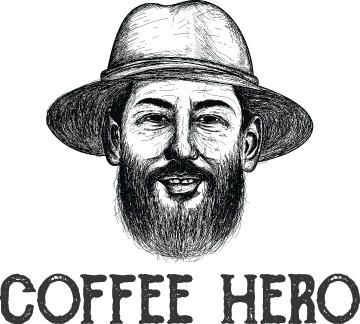
COFFEE SUGAR LEVEL EXPLAINED
Your daily coffee can have vastly different sugar levels. A black coffee contains almost no sugar on its own. The total sugar content comes from the type and amount of milk, any added sugar, and flavoured syrups. This guide explains where the sugar comes from in your favourite Australian cafe drinks, from a standard flat white to a caramel latte, helping you make more informed choices about what’s in your cup.
The Starting Point: Sugar in Black Coffee
Before we look at milky coffees and flavoured options, it's important to start with the base. Pure, brewed black coffee, whether it's an espresso, a long black, or a filter brew, contains almost no sugar at all. The rich, complex flavours you taste come from the natural oils and compounds within the roasted coffee beans, not from sugar. This means that if you drink your coffee black, you are starting with a virtually sugar-free beverage. This is the baseline from which the sugar content of all other coffee drinks is built.
The Role of Milk in Your Coffee's Sugar Content
For most Australian coffee drinkers, a splash or a cupful of milk is essential. This is where the first type of sugar enters the picture. The primary source of natural sugar in a standard white coffee comes from lactose, which is the sugar naturally present in cow's milk. It is important to remember that this is a naturally occurring sugar, not an added sugar that you might stir in from a packet. The amount of sugar can vary depending on the type and quantity of milk you use.
Comparing Different Milk Options
The milk you choose for your flat white or latte has a direct impact on the final sugar content. A standard 250ml serving of full cream cow's milk contains around 12 grams of natural sugar. Skim milk has a slightly higher concentration of lactose, so it contains a little more sugar per serving.
In Australia, the demand for alternative milks has grown significantly. It's useful to know how they compare. Unsweetened almond milk typically has very low sugar content. Soy milk is also a lower-sugar option. However, oat milk, a very popular choice in cafes for its creamy texture, is naturally higher in sugar than other plant-based milks. Always check the nutrition panel if you are buying for home, as some brands contain added sugars.
At Coffee hero, we ensure that coffee beans are properly roasted. We treasure our coffee beans and care about them. With our masterful techniques, we always bring out the best from every coffee bean. Most people have a favorite coffee roast. Do you have one? Before now, darker roasts were popular, but with the coming of specialty coffee, lighter roasts are now more popular. So read on to find out more, you may just get a new favorite roast.

The coffee beans start first as a cherry plant. They are harvested and processed. That is, the beans are removed from the cherry, then they are dried (or wet washed) before being exported to other parts of the world.
Understanding Added Sugars in Cafe Coffee
This is where the sugar content in a coffee can increase dramatically. Added sugar refers to any sugar that is not naturally occurring in the ingredients. This includes the spoonfuls of white or raw sugar you stir in yourself, but more significantly, it includes the flavoured syrups used by baristas. A single pump of vanilla, caramel, or hazelnut syrup can add an extra 8 to 10 grams of sugar to your drink. A standard large-sized flavoured latte might contain three or four pumps, quickly turning your coffee into a high-sugar beverage. Other sources of added sugar include the chocolate powder used on a cappuccino and the chocolate sauces used to make a mocha.
A Look at Sugar in Popular Australian Coffee Orders
Understanding the makeup of your favourite drink can help you make better choices. Here is a simple breakdown of what to expect from common orders at an Australian cafe.
The Flat White and Latte
A standard, unsweetened flat white or latte is a relatively low-sugar choice. Its sugar content comes almost entirely from the natural lactose in the milk. If you don't add any sugar yourself, you are getting a straightforward drink where the coffee flavour is the star.
The Cappuccino
A cappuccino is very similar in its sugar profile to a latte or flat white. The main difference is the dusting of chocolate powder on top. While this adds a small amount of added sugar, it is usually not significant unless you ask for extra.
Flavoured Lattes and Mochas
These are the drinks that typically contain the most sugar. A mocha contains both the natural sugar from milk and significant added sugar from chocolate syrup or powder. Flavoured lattes are in the same category, with their high sugar content coming directly from the sweet syrups used to create the flavour.
Iced Coffees
There is a big difference between types of iced coffee in Australia. A modern iced latte, which is simply an espresso shot, milk, and ice, has the same sugar profile as a hot latte. However, a traditional Australian-style iced coffee, often made with a scoop of ice cream, flavoured syrup, and whipped cream, is much higher in added sugar and is more of a dessert than a daily coffee.
How to Order a Low-Sugar Coffee
You don't have to give up your cafe visit to manage your sugar intake. With a few simple adjustments, you can easily order healthy coffee options.
-
Start with a black coffee base if you enjoy it, as it's naturally sugar-free.
-
If you have milk, stick to standard, unflavoured options.
-
If you like flavoured coffee, ask the barista for only one pump of syrup instead of the standard two or three.
-
Ask if the cafe offers sugar-free syrups, which are becoming more common.
-
Instead of using sweeteners, try spices like cinnamon to add flavour without sugar.
-
Order a small or regular size instead of a large one to automatically reduce the amount of milk and syrup.
Summary On Coffee Sugar Levels
To summarise, the sugar in coffee is almost entirely dependent on what you add to it. A black coffee is the perfect starting point as it is naturally sugar-free. The main sources of sugar are added sugars from teaspoons of sugar and flavoured syrups, while milk contributes natural sugars through lactose. Being mindful of these extras is the most effective way to manage your sugar intake. These simple adjustments can help you continue enjoying your daily coffee as a healthy coffee option.
Contact us. Coffee Hero is your partner for residential and commercial coffee.
Frequently Asked Questions About Coffee Sugar Levels
Does Coffee Itself Have Sugar?
No, pure brewed coffee made from roasted beans contains a negligible amount of sugar and calories. Any sugar content in a coffee drink comes from additives like milk, sugar, or flavoured syrups.
How Much Sugar Is in a Regular Coffee With Milk?
A regular flat white or latte (around 250ml) made with full cream milk and no added sugar contains approximately 12 grams of natural sugar (lactose) from the milk itself.
Which Coffee Has the Most Sugar?
Commercially made flavoured coffees, such as a large caramel latte or a mocha, typically have the most sugar due to the multiple pumps of syrup and chocolate sauces. A traditional Australian iced coffee with ice cream and syrup is also very high in added sugar.
How Much Sugar Is OK in Coffee?
Health guidelines generally recommend limiting added sugars. While there's no set rule for coffee, being mindful is key. If you have one teaspoon (about 4 grams) of sugar, that is a modest amount. The concern grows with multiple sugars or flavoured syrups, which can quickly add up.
Is It Unhealthy to Put Sugar in Coffee?
Putting a small amount of sugar in your coffee isn't necessarily unhealthy on its own. The issue arises when high-sugar coffees contribute to an excessive overall daily sugar intake, which is linked to various health problems. Moderation is the key.
How Can I Sweeten My Coffee Without Sugar?
You can try natural sweeteners like stevia or monk fruit. Alternatively, adding spices like cinnamon or a drop of vanilla extract can create a sense of sweetness and flavour without any sugar.
Explore our store and arm yourself with the best coffee beans in Australia.

